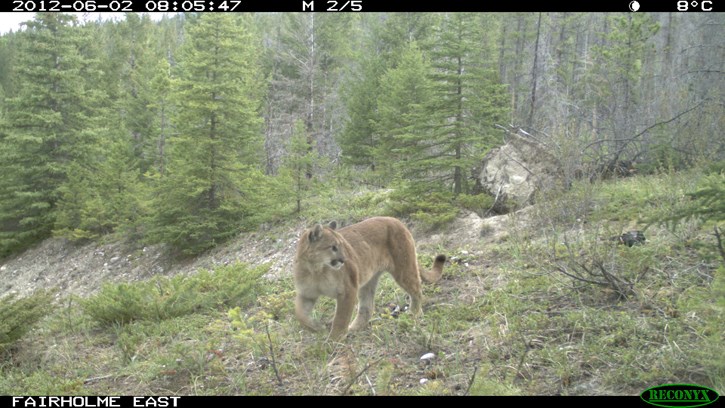CANMORE – A local man walking his dog came dangerously close to a cougar feeding on a deer at Quarry Lake last week.
The close encounter prompted a warning from Alberta Environment and Parks for residents and visitors to be vigilant and aware that deer and elk, and their calves, can draw large predators such as cougars and bears into town.
“They walked in on the cougar pretty close,” said Jay Honeyman, a human-wildlife conflict specialist for AEP, noting they moved the deer carcass away from the trail and further into the forest away from people. No details on exactly where and when the incident occurred, or whether the cougar quickly took off or guarded its kill, were immediately available.
“This is an example of how these prey species are bringing carnivores into town and we want to wave a bit of a flag. We’re not just blowing smoke. They are here and we’ve had incidents.”
Efficient ambush hunters, cougars are solitary and can be active any time of day, but most often hunt at dusk, night and dawn. They eat deer, elk and bighorn sheep, but they will prey on feral rabbits and have killed pet dogs in Canmore before.
Attacks on humans are extremely rare. Alberta’s only fatality occurred in 2001, when a cougar killed Canmore’s Frances Frost, 30, as she was cross-country skiing near Lake Minnewanka in Banff National Park.
According to data from AEP, there were 381 cougar occurrences from 2000-18 within the Bow Valley, stretching from the east boundary of Banff National Park to Kananaskis River, and 284 of these occurred within Canmore.
Of the total occurrences, 201 were in residential areas, again mostly in Canmore. The hot spots are on both sides of the valley, including Eagle Terrace and Cougar Creek on the north and the Peaks of Grassi and Rundleview neighbourhoods on the south side.
“Cougar activity is mostly on the periphery of town up against the corridors,” said Honeyman.
“It peaks in July, as well as in winter when deer and elk move further into town to avoid predation by cougars and wolves.”
The Bow Valley human-wildlife coexistence round table recommended keeping prey species such as elk and deer out of town, which is becoming an increasing problem in Canmore as they seek a safe haven from predators.
Honeyman said having elk and deer in town draws cougars and other carnivores like bears and wolves into the community, where they come into closer contact with people and can take advantage of opportunities to get pets.
“They’re chasing the deer and then they turn left and see Fido; they can’t get the deer and they get the dog instead,” said Honeyman.
Of the 381 occurrences, 240 were essentially cougars seen travelling through residential areas and urban green spaces in the valley, with 32 of those involving cougars hunting wildlife or feeding on carcasses right in residential areas and urban green spaces.
Cougars have also followed or chased people and pets, according to the AEP data, but that mostly occurred when folks were walking their dogs, which could be the reason for the cougar’s interest in the first place.
Honeyman said all this points to the fact that residents and visitors have to be vigilant, noting having cougars in town is a significant public safety issue.
“Our hands get tied at a certain point,” he said, referring to six cougars that were killed by wildlife managers for public safety reasons in the past 18 years.
“We come in and do all the dirty work; it’s not because we’re bad guys, it’s because the system isn’t working quite like we’d like it to. This has to be a group effort.”
With elk calving season currently underway and continuing into June, elk are giving birth in and around town, and that’s a food source for carnivores.
Nick De Ruyter, Bow Valley WildSmart program director, also noted deer are the main food source here for cougars year-round.
“That’s another big reason that we can’t have people feeding elk and deer and leaving food in their backyards; keeping them in town will draw predators into town,” he said.
Another recommendation, which came out of the Bow Valley human-wildlife coexistence round table, is to block off or secure areas beneath decks, where both cougars and bears have been known to seek cover in Banff and Canmore.
“Don’t let wildlife access underneath your houses. They can feel quite safe and secure under there and we don’t want that,” said De Ruyter.
According to the AEP figures, 29 cougars were reported or found dead between 2000-18.
The main source of cougar mortality in Alberta is hunting, but in the Bow Valley it is human-caused mortality on the roads and railway line, accounting for 18 cougar deaths.
Cougar hunting, which is commonly done using hounds, is allowed in some areas of the Bow Valley, but a big chunk is wildland park where dogs must be on leash.
“Basically you can’t have a dog off-leash, so why would you come and hunt them here,” said Honeyman.
To avoid a cougar encounter, people are encouraged to travel in groups, be especially cautious when travelling at dawn and dusk, travel slowly if cycling or jogging; make noise to alert cougars, carry bear spray in an easily accessible location and know how to use it, keep dogs on leash, and leave the area if you see or smell a dead animal.




